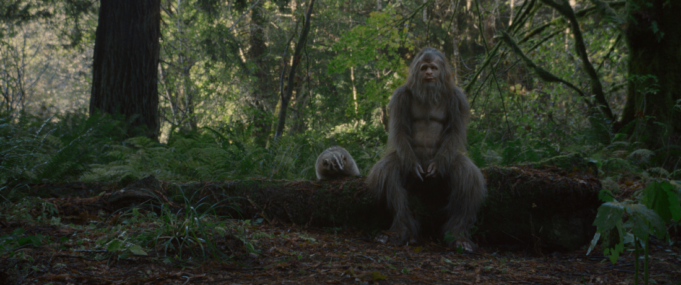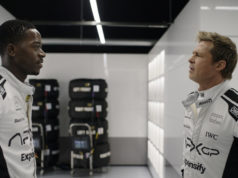I don’t know if Sasquatch Sunset will wind up being the strangest movie I see in 2024, but it will definitely be a big part of the conversation. It is a movie about a family of sasquatches who have no direct contact with human beings and communicate only in grunts, whoops, and shrieks. How in the world do you make a viable movie out of these characters? There’s probably a way. In fact, there’s probably several ways. However, I’m afraid the Zellner brothers haven’t cracked it.
The story takes up a year in the lives of four creatures (Jesse Eisenberg, Riley Keough, Christophe Zajac-Denek, and Nathan Zellner) who live in an unspoiled stretch of the Pacific Northwest — or it appears unspoiled until the family discover a red X on a tree in their forest and wonder what could have made it.
This is the work of Nathan Zellner and his older brother David, who previously did sharply distinctive work with their tragic adventure film Kumiko the Treasure Hunter and their revisionist Western Damsel. (They also directed half the episodes of The Curse.) Within the first five minutes of this movie’s beginning, they show sasquatch copulation. That’s how committed they are to their premise. Also, to all the men reading this, the sight of sasquatch penises will likely make you feel better about your own. The creatures do all their business out in the open, so be prepared to see pee and poop as well.
You can see the brothers’ considerable strengths as filmmakers, as the thick vegetation of the northern California location looks amazing. The lack of dialogue puts great pressure on the music, and The Octopus Project (the Austin collective who have scored all the Zellners’ films) comes through with an appropriately rustic and odd combination of acoustic and electronic instruments. Maybe most impressive of all is the creature design by Steve Newburn, as the sasquatches’ hairy naked bodies come off as real. The actors wholly perform their roles, too, moving about like a forgotten branch of primates.
To what end, though? Movies about Bigfoot are often about the romance of peoples who have been untouched by civilization. I’m glad the Zellners don’t suggest that the sasquatches are living some purer form of existence than us, but the filmmakers don’t seem to have a clear viewpoint on what their story is about. The final shot of the surviving sasquatches stopping outside a Bigfoot museum implies that this is about Native Americans who have been overtaken by progress. That’s a worrying implication, especially since some of these creatures die because they’re stupid. (The patriarch tries to rape a mountain lion and gets eaten for his troubles. And you wonder why the sasquatches are endangered.) Nor does the movie have much to say about being the last of a species, when every member’s death is a disaster. The one clue to the movie’s timeframe is when the sasquatches find a campsite with a cassette tape player playing Erasure’s “Love to Hate You,” and while that leads to a surreal and destructive rampage, it fails to say much about humans encroaching on wild spaces.
I’d still watch Sasquatch Sunset again over any of the recent Planet of the Apes movies. That doesn’t change the fact that at 88 minutes, it still goes on too long without coming to a point. If you watch this, you may want to bring a small book to read during its dull stretches.
Sasquatch Sunset
Starring Riley Keough and Jesse Eisenberg. Written and directed by David and Nathan Zellner. Rated R.












